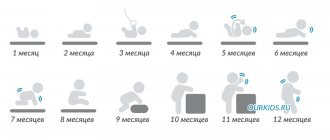What happens to a child’s body from one to one and a half years old?
At this age, children continue to develop the chewing apparatus, a sufficient number of teeth appear - by the age of 1.5 years, children should already have 12 teeth. The activity of digestive juice and enzymes also increases, but their functions still do not reach full maturity. The volume of the stomach increases - from 200 to 300 ml. Gastric emptying occurs on average after 4 hours, which allows you to eat 4-5 times a day.
The daily amount of food (excluding liquids consumed) for children from one to one and a half years old is 1200-1250 ml. This volume (including calorie content) is distributed among feedings in approximately the following ratio: breakfast - 25%, lunch - 35%, afternoon snack - 15%, dinner - 25%. The volume of a single meal can be 250 ml, taking into account 5 feedings a day, and 300 ml with 4 feedings a day.
Possible nutrition problems
As practice shows, consumption of cottage cheese by a child can have not only beneficial, but also harmful effects on his body.
Contraindications to the use of this product are:
- Pathologies of the kidneys and other organs of the urinary system;
- Disturbance in the gastrointestinal tract;
- Individual intolerance.
Important! If, after introducing complementary foods, the baby experiences colic, flatulence, or a rash, the product should be excluded from the diet.
Cow's milk protein is the most common allergen for newborns. Particular sensitivity to this component is explained by the fact that:
- Mom often consumed dairy products, as well as veal and beef while breastfeeding;
- The baby was fed artificial formula for a long time (the basis of the product is often cow's milk);
- Too active intake of protein into the body with insufficient intestinal maturity.
If you are allergic to cow protein, you should avoid eating cottage cheese. There is a possibility that such a child’s body will be tolerant to goat’s milk protein, so in this case you can feed the baby with goat’s curd. If replacement is not possible, a special split milk formula can be used as an alternative. However, this issue is best resolved with the help of a pediatrician, who will also prescribe appropriate treatment for the child. The use of the product should be limited in case of excess nutrition, as well as if the baby is overweight or obese.
On a note. Excess weight in infants that occurs as a result of overfeeding is called paratrophy (indicators must deviate from the standard by at least 10%). This condition has three degrees, which are differentiated depending on the amount of excess of the norm (by 11-20%, by 21-30% or by 31% or more). If a child over a year old has similar deviations, then we are no longer talking about paratrophy, but obesity (which has 4 degrees).
Signs of allergies
According to official statistics, about 8 percent of newborns are susceptible to allergies. After several years, this problem usually goes away on its own.
Symptoms of an allergic reaction to cottage cheese complementary foods include:
- Itching, rash and redness on the skin;
- Peeling of the dermis;
- Swelling of the extremities;
- Pain in muscles and ligaments;
- The appearance of circles under the eyes;
- Swelling in the eyelids or lips;
- Drying of the oral mucosa;
- The appearance of a runny nose, cough, bronchitis;
- Sneezing;
- Abnormal stool;
- Colic;
- Nausea and vomiting;
- Rash on the skin around the anus;
- Lethargy, drowsiness;
- Sleep disturbance;
- Anxiety, restlessness;
- Hyperactivity;
- Headache;
- Tearfulness.
Cottage cheese as complementary food is one of the best options for newborn babies. This product has a lot of useful properties, rarely causes allergies and has virtually no contraindications. However, in order to exclude a possible negative reaction of the child’s body to complementary foods, it is recommended to first consult with a pediatrician.
Nutrition for a child from one year old
For children 1-1.5 years of age, dishes with a mushy consistency are preferable. If a child’s chewing teeth (baby molars) have erupted by this age, he can be offered whole pieces of food no larger than 2-3 cm in size. The child develops a sense of taste, an attitude towards food, the first preferences and habits begin to form. The baby begins to develop a conditioned food reflex during meals, which ensures sufficient, rhythmic secretion of digestive juices and good absorption of food. That is why it is important to follow a diet for 1 year, to expand the diet by introducing new products and dishes.
The child’s cognitive and motor activity increases, and along with it, the body’s energy consumption increases. The physiological need for energy in the age group from 1 year to 1.5 years is on average 102 kcal per 1 kg of body weight. With an average body weight of 11 kg, it is 1100 kcal per day.
The main requirements for a child's diet from one year onwards are variety and balance in basic nutrients (proteins, fats, carbohydrates, minerals, vitamins). Combinations of dishes from vegetables, cottage cheese, cheese, milk, animal and poultry meat, eggs, cereals and flour products are required.
The basis of the diet of a baby from 1 to 1.5 years
- these are products with a high content of animal protein: milk, dairy and fermented milk products, meat, poultry, eggs. The child should receive dishes from these products, as well as from vegetables, fruits and cereals, daily.
Cottage cheese
Cottage cheese, strawberry and banana puree
Homemade cottage cheese and store-bought varieties of cottage cheese “without added salt” are a very healthy addition to a child’s diet. After all, cottage cheese contains many healthy fats and proteins, as well as some B vitamins, calcium, selenium and zinc.
However, the vast majority of cottage cheese on the market contains sodium—up to 800 mg in one cup—that's nearly four times the sodium found in the average serving of fast-food fries. Even brands labeled “low salt” can have high sodium levels for little ones.
When choosing cottage cheese for children, you need to look for the following options:
- Pasteurized
- Low sodium (ideally less than 100 mg sodium per serving)
- From whole milk
- No added preservatives or sugar
I believe that cottage cheese is best introduced into complementary foods after 12 months, but most pediatricians recommend it already at 6-10 months or after the first teeth erupt. The parents decide, but I would not rush, especially if the child receives high-quality formula or breast milk.
Breakfast of grain curd, strawberries and pomegranate
Approximately 40 grams of cottage cheese can be given up to 3 years of age, judging by the book “Clinical Dietetics of Children by T.E. Borovik, K.S. Ladodo , but A. V. Levadnaya indicated a norm of 80 grams, however, it does not include the age of the child.
I am writing all this because after a year a child has a large assortment of dairy products. Now mom can masterfully juggle food products, offering either cottage cheese or milk, but more often just mixing everything. This is how amazing family dishes are born in the form of oatmeal with cottage cheese or a fruit smoothie made from kefir, etc. Don’t be afraid to mix; perhaps your baby will like some version of dairy dishes more than store-bought yoghurts.
I will also note that most often it is not recommended to mix milk with fruits, vegetables and eggs; I have not seen such information about yogurt and other products. That’s why I rarely add milk to smoothies, and if I do, it’s a little bit for a liquid consistency.
Below I offer examples of baby milk nutrition for 1-3 years. All information from books. I decided not to post the menu, I have it in the article “Menu for Children”, I don’t want to repeat myself, but I’ll give you new ideas for preparing children’s milk recipes.
Dairy products for children over one year old
Milk, dairy and fermented milk products play an important role in the nutrition of a 1-year-old child.
.
They contain easily digestible proteins, fats, vitamins, and minerals.
Fermented milk products contain lactic acid bacteria, which regulate the functioning of the gastrointestinal tract, have a positive effect on the intestinal microflora, improve digestion, and increase the child’s immunity. Milk, kefir, and yogurt should be included daily in the diet of a healthy child, and cream, cottage cheese, sour cream and cheese can be used after one or two days. For children with normal body weight, foods with a reduced percentage of fat content are not acceptable; the diet uses milk with 3.2% fat content, kefir 2.5-3.2%, yoghurts 3.2%, sour cream up to 10%, cottage cheese like milk , and creamy - 10% fat. The total amount of milk and fermented milk products should be 550-600 ml per day, taking into account the preparation of various dishes. Of these, a child can receive 200 ml of kefir intended for baby food daily. For babies with cow's milk protein intolerance, it is best to postpone introduction to whole milk[1] until later (up to 2-2.5 years), and instead continue to use formulas for the second half of life (they are made from whole milk powder without the addition of dairy serum).
One-year-old babies can receive only specialized children's milk (not creamy) yogurt with a moderate content of fats and carbohydrates in a volume of up to 100 ml per day. Cottage cheese, as a source of protein and calcium, is required for children within 50 g per day. Sour cream or cream 5-10 g can be used to season first courses; hard cheeses up to 5 g in crushed form are used in the nutrition of a baby in the second year of life after 1-2 days.
How much cottage cheese can a child have? Advice from practicing pediatricians
If you ask your local pediatrician about how much cottage cheese a child can eat before and after one year, the doctor, of course, will answer the question as recommended by WHO. However, there are many nuances when introducing complementary foods and subsequently organizing the child’s nutrition. There are children who categorically refuse to eat cottage cheese, or, on the contrary, love it very much and ask for more than is prescribed in the norms. In this case, practicing pediatricians recommend not insisting on taking strictly 30 g of cottage cheese every day, but diversifying the menu and offering an alternative to the baby.
The main criterion that you should focus on is the baby’s physical health, normal weight gain, and psychomotor development according to age. If all these indicators are normal, then only reasonable restrictions on the content of cottage cheese in the child’s diet should be introduced. For example, if a child does not eat cottage cheese every day, and this does not in any way affect his growth and development, there is no need to worry too much about this. Children over 12 months can be offered dishes made from processed cottage cheese: lazy dumplings, cheesecakes, soufflés and casseroles.
There should still be a limit on the maximum amount of cottage cheese per day for children. If we are talking about the norm of 30 g for children under 9 months, this means that 30 g is the maximum amount of cottage cheese per day that a child can eat without harm to health. For children from 9 months to 10 years, the intake ranges between +/- 10 g from the 50 g recommended by WHO. Children over 11 years old can eat up to 100 g of cottage cheese per day, provided that the norm is not exceeded daily.
The famous Ukrainian pediatrician Evgeniy Komarovsky adheres to the same position. When parents contact him with the question of how much cottage cheese a child can eat before and after one year, he replies that the concept of “norm” should not be taken too literally. If the Institute of Nutrition has established a daily norm, this does not mean that the child’s nutrition should become monotonous in terms of quantity and quality of food. One day the baby may eat a spoonful less of cottage cheese, another day more, or not eat this product at all for several weeks. Nothing terrible will happen to a healthy child due to such deviations in nutrition and will not harm his health.
Pediatricians pay special attention to the appearance of deviations in the development of the child. If the dentist notices white streaks on a child's teeth, this means that the child is not getting enough calcium in the diet. In this case, it is simply necessary to introduce cottage cheese into the child’s daily diet. Other signs of calcium deficiency may include poor sleep, excitability, moodiness of the child, cramps in the limbs, and complaints of pain in the gums.
What kind of meat can a child eat?
The amount of meat in a 1-year-old child’s diet gradually increases .
Canned meat, meat soufflé, meatballs, minced meat from lean varieties of beef, veal, pork, horse meat, rabbit, chicken, turkey in the amount of 100 g can be given to the child daily, preferably in the first half of the day, given their long period of absorption. The expansion of the diet occurs due to the introduction of offal - liver, tongue and children's sausages (the packaging indicates that they are intended for young children). Sausages are not included in the list of “allowed” products.
How much yolk should I give a 10 month old baby?
Useful properties of eggs
- The norm for one-time consumption is 0.5 yolks (hard-cooked)
- Consumption frequency: every 2-3 days
In this case, we are talking about chicken eggs. For quail eggs, slightly different standards are recommended.
You can't spoil porridge with oil
Vegetable oil
in a daily norm of 6 g, it is advisable to use it raw, adding it to vegetable purees and salads.
The child fats of animal origin with sour cream and butter
(daily allowance up to 17 g).
By the way, in the diet of children over one year old, it is still recommended to widely use gluten-free cereals
[2] (buckwheat, rice, corn), gradually introducing oatmeal. It is recommended to give porridge once a day in a volume of 150 ml. Until 1.5 years old, you should not offer your child pasta rich in carbohydrates.
The food package for children 1-1.5 years old should include bread
various varieties of rye flour (10 g/day) and coarse wheat flour (40 g/day) Cookies and biscuits can be given 1-2 pieces per meal.
From the book “We Eat Tasty.” From first feeding to 5 years" Annabelle Carmel
(CLICK on the picture to enlarge it!)
Mashed potatoes with carrots, broccoli and cheese
Risotto with butternut squash
Risotto with butternut squash
Cheese sauce with pumpkin
Haddock with carrots and peas
Haddock with carrots and peas
We create a fruit and vegetable menu for children
Vegetables
are important as a source of carbohydrates, vitamins, mineral salts, dietary fiber, and should be widely used in the nutrition of children from 1 to 1.5 years old in the form of vegetable purees. The daily volume of vegetable dishes from cabbage, zucchini, carrots, pumpkin with the addition of onions and herbs is 200 g. And potato dishes - no more than 150 g, because it is rich in starch, which slows down metabolism. Young children, as well as children with functional disorders of the gastrointestinal tract, should not be offered garlic, radishes, radishes and turnips.
In the absence of medical contraindications (for example, food allergies), children should receive 100-200 g per day of fresh fruit
and 10-20 g
of berries
. They also benefit from various fruit, berry (preferably without sugar) and vegetable juices, rosehip decoction (up to 100-150 ml) per day after meals. It is not recommended to use jelly in the diet of young children, since they unnecessarily enrich the food with carbohydrates and their nutritional value is low.
Role in the human diet
People have been using cottage cheese for a long time. It is made by heating natural milk and expressing the whey that is released. For people, it is a real storehouse of useful substances : amino acids, vitamins A, E, C, B1, B2, B12, a number of useful microelements: potassium, calcium, sodium, magnesium, phosphorus, iron, zinc, copper, fluoride, lack of lactose , and most importantly - how much protein!
Indeed, cottage cheese compares favorably with other dairy products precisely because of its high protein content. In addition, during the fermentation process, the casein protein coagulates, and this increases its digestibility . This protein perfectly saturates the human body and is involved in the process of formation and restoration of muscle tissue. Calcium and phosphorus serve as materials for building bone tissue and strengthening teeth.
Cottage cheese is recommended for everyone to eat - children, the elderly, expectant mothers, athletes, and workers in hazardous industries.
Like any other product, cottage cheese in excessive quantities will not bring benefit, but harm:
- Eating a lot of fatty foods will increase your blood cholesterol levels.
- Frequent consumption can cause kidney problems due to the high protein content.
- This is a perishable product. It’s easy to get poisoned by expired or low-quality products.
Important: The shelf life of any cottage cheese is no more than 3 days after opening the package.
Compote will not replace water
Do not forget that the child must receive a sufficient amount of fluid. There are no norms for the volume of additional liquid; the baby needs to be given water on demand (during feeding, in between feedings). It is best to offer your child boiled water, baby drinking water, weak teas or baby teas. Sweet drinks - compotes, fruit drinks, juices do not compensate for the lack of fluid, and the sugar they contain reduces appetite and increases the load on the child’s . Make sure that liquid is available to your baby between feedings.
Norms for introducing cottage cheese in the first year of life
Like everything new, cottage cheese should be introduced into complementary foods gradually and very carefully, observing the child’s reaction, since the necessary enzymes are just beginning to form and this process occurs individually for everyone. Therefore, each child will have his own mode of getting used to a new product. There are several rules to follow:
- For the first time, the daily intake of cottage cheese will be no more than half a teaspoon. If you have concerns, this dose can be given every other day or two so as not to overload the body.
- It is necessary to carefully monitor the baby’s reaction: whether there is a rash or disturbances in the gastrointestinal tract. If everything is fine, then you can gradually increase the dosage.
- Continue to monitor the reaction to increasing the norm.
- The average dose per year should be about 50 g. Of course, deviations in one direction or another are possible.
- If an allergic reaction occurs, you should stop giving the cottage cheese for a while.
New dishes for a 10 month old baby: soups, meatballs, steamed cutlets
By 10 months, the baby’s menu includes all the basic foods, but they need to be prepared correctly, preserving all the beneficial properties. Below are several recipes that will diversify the baby’s menu and will not take much time to prepare.
Nutrition for a child up to one year: soup with buckwheat meatballs
Nutrition for a child up to one year: steamed fish cutlets











